Exploring Extra Large Bat Houses for Ecosystem Health
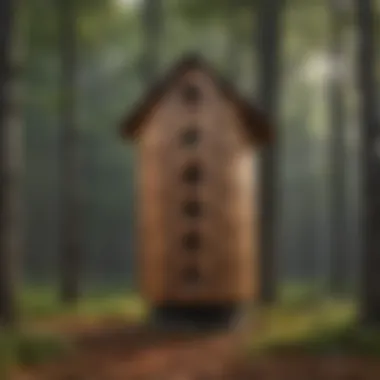
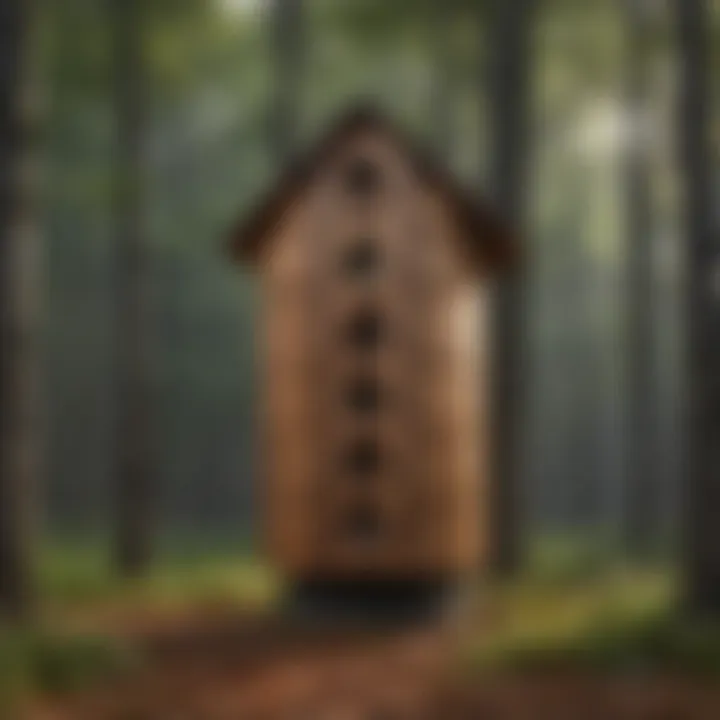
Intro
Extra large bat houses are not just a means of providing shelter for bats; they are integral components of a healthy ecosystem. This article aims to delve into their benefits, effective designs, and proper implementation strategies. Understanding the role of bats and their needs is crucial for promoting biodiversity. The intricate relationships within woodland ecosystems highlight the importance of such initiatives, particularly in combatting declining bat populations.
Understanding Woodland Ecosystems
Woodland ecosystems serve as vital habitats for numerous species, including bats. These ecosystems are complex and highly interconnected, playing a significant role in the overall health of the environment.
Importance of Biodiversity in Forests
Biodiversity enhances resilience against environmental changes. A diverse array of species contributes to the stability of ecosystems, allowing for natural pest control and pollination. Bats, for instance, are natural predators of insects, helping to maintain a balanced population of pests. The presence of varied plant species also supports the livelihoods of bats by providing food and shelter, creating a symbiotic relationship.
Role of Forests in Climate Regulation
Forests play a critical role in climate regulation. Through photosynthesis, trees absorb carbon dioxide, a significant greenhouse gas. Additionally, forests influence local weather patterns, affecting humidity and temperature levels. When bat houses are integrated into these environments, they promote healthy insect populations, which in turn optimizes plant health and supports sustainable forestry practices.
"Every species, including bats, contributes to the ecological balance within woodland ecosystems. Their decline can lead to broader implications for biodiversity."
Sustainable Forestry Practices
Implementing sustainable forestry practices is key to enhancing woodland health. By balancing human needs with ecological integrity, we can ensure that forests continue to thrive for future generations.
Principles of Sustainable Forestry
Sustainable forestry emphasizes the responsible management of forest resources. Key principles include:
- Promoting Biodiversity: Protecting various plant and animal species.
- Selective Logging: Minimizing habitat destruction by extracting only certain trees.
- Restoration Efforts: Renewing ecosystems that have been degraded by human activities.
- Community Involvement: Engaging local communities in forest management decisions.
Case Studies of Successful Implementations
Regions that have embraced sustainable forestry have showcased significant benefits. For example, initiatives in the Pacific Northwest have led to increased wildlife populations, including bats, while maintaining timber productivity. The collaboration between environmentalists and forestry professionals has yielded successful outcomes, encouraging the adoption of similar practices worldwide.
Woodland Stewardship Techniques
Effective woodland stewardship requires proactive management strategies that align with conservation goals.
Forest Management Plans
Developing comprehensive forest management plans is essential for guiding stewardship efforts. These plans should include:
- Specific objectives for wildlife conservation.
- Detailed mapping of habitats and species distributions.
- Monitoring protocols to assess the health of ecosystems over time.
Conservation Strategies
Employing various conservation strategies can bolster bat populations. Some effective methods include:
- Installing extra large bat houses to provide adequate roosting space.
- Preserving existing tree cavities that bats use for shelter.
- Conducting regular population surveys to track changes in bat communities.
By integrating these strategies, we can foster a habitat that not only supports bats but also enhances woodland ecosystems overall.
Understanding Bats and Their Ecology
Bats are vital components of many ecosystems around the world. Understanding their ecology helps in recognizing the intricate relationships these creatures share with their environment. Bats contribute to pest control, pollination, and seed dispersal, thereby supporting biodiversity. The availability of bat houses can significantly enhance their populations, leading to better ecological balance.
The Role of Bats in Ecosystems
Bats serve multiple functions within ecosystems. They are among the primary nocturnal predators of insects, consuming vast quantities of pests like mosquitoes, moths, and beetles. This predation is crucial for agricultural health, as it reduces the necessity for chemical pesticides. According to studies, a single bat can eat over 1,000 insects in a night.
Additionally, some bat species are effective pollinators, helping to fertilize various plants. They facilitate the reproduction of plants that require night pollination. Many plants, including some fruit-bearing species like mangoes and bananas, depend on bats for pollination. Moreover, certain bats contribute to seed dispersal, aiding in forest regeneration and habitat recovery.
Common Species of Bats
Several species of bats are essential to various habitats. The Little Brown Bat, found in North America, is known for its role in controlling mosquito populations.
The Mexican Free-tailed Bat is another significant species as they can travel long distances, benefiting both local environments and agriculture.
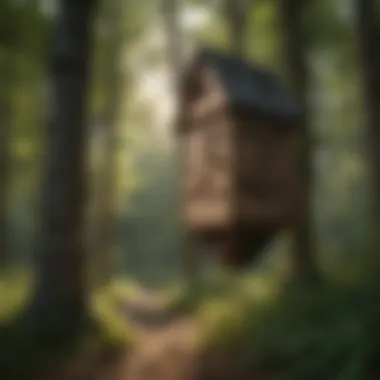
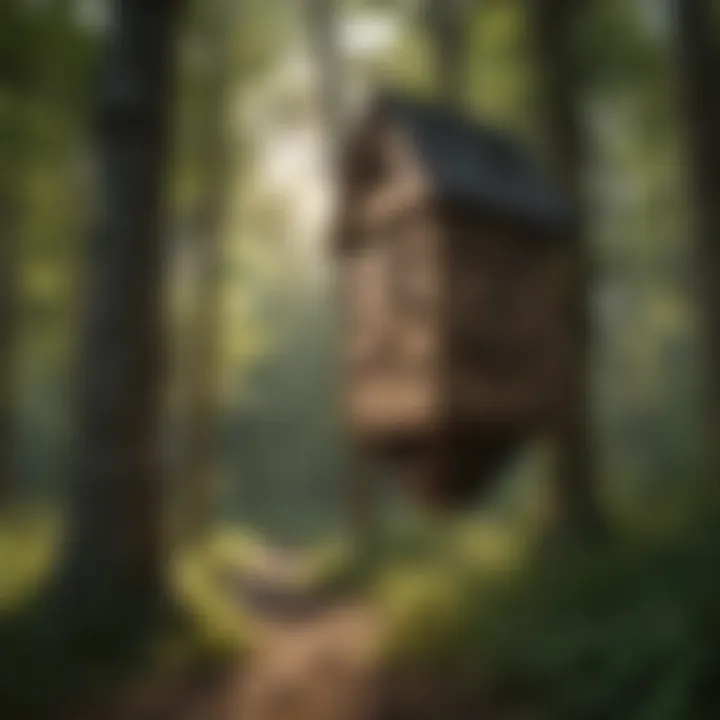
In other regions, the Fruit Bat, or Flying Fox, is recognized for its pollination and seed dispersal abilities, making it an important species for many tropical ecosystems. The variety among bat species emphasizes the need for tailored bat house designs to accommodate habitat preferences of different bats.
Bat Habitats and Behavior
Bats typically roost in dark, sheltered locations that provide safety from predators and harsh weather. Common habitats include caves, trees, and man-made structures.
Their behavior varies significantly among species. For example, many bats exhibit colonial living, forming large groups for roosting. Consequently, building sizeable bat houses allows for community roosting styles, thus enhancing species survival.
Understanding bat behavior is vital when implementing bat houses. Factors like temperature, humidity, and sunlight exposure play critical roles in attracting bats. Proper attention to these elements can maximize the effectiveness of extra large bat houses.
The Importance of Bat Houses
Bat houses serve a crucial role in supporting bat populations while providing various ecological benefits. As natural pest controllers, bats contribute significantly to maintaining healthy ecosystems. However, urbanization and habitat loss have led to declining bat numbers. Thus, constructing bat houses is increasingly important.
Promoting Biodiversity
Bats play a vital role in biodiversity. They are pollinators for many plants and disperse seeds, contributing to forest regeneration. By installing bat houses, individuals contribute to a balanced ecosystem. The presence of bats can help diversify local insect populations as well.
Bat houses offer a haven for species at risk. For instance, the little brown bat is endangered across many areas due to habitat loss. By creating structures that allow them to roost safely, we can support their populations. This action not only helps bats but ensures a more sustainable environment for other species.
Pest Control Benefits
The most notable benefit of bat houses is pest control. Bats consume vast quantities of insects, which is beneficial for farmers and gardeners. Each bat can eat thousands of insects in a single night, including mosquitoes, moths, and beetles.
This natural pest control reduces the need for chemical pesticides, promoting a healthier environment. Farmers might see a decrease in crop damage since bats actively hunt insects that can be harmful to plants. Therefore, bat houses serve as an economical and eco-friendly method of managing pest populations.
Conservation Efforts
Constructing bat houses is part of larger conservation efforts. Bats are often misunderstood and face negative stigma. Conservation initiatives help to raise awareness about their critical role in ecosystems. These structures offer a way for communities to engage in bat conservation activities.
Creating bat houses encourages local participation in wildlife management. Schools and community groups can take part in construction projects, fostering a sense of ownership in wildlife preservation. Furthermore, allowing bats to thrive benefits overall ecosystem health, making bat houses a win-win solution for nature and communities alike.
Designing an Extra Large Bat House
Designing an extra large bat house is critical for fostering bat populations and promoting overall ecosystem health. The growth in bat house popularity responds not only to increasing awareness of bats’ ecological roles but also to concerns about declining bat populations due to habitat loss, disease, and pesticides. By creating a well-designed bat house, individuals or organizations can provide a safe, suitable habitat for various bat species. This section will highlight key elements, benefits, and considerations that must be addressed in the design process.
Size Specifications
When designing an extra large bat house, size is paramount. The dimensions of the bat house directly influence the number and variety of bats it can host. Larger bat houses can accommodate more individuals and diverse species, which is crucial for maximizing biodiversity. Generally, the minimum dimensions for a proper extra large bat house should be at least 4 feet tall, 2 feet wide, and 2 feet deep. These dimensions create a favorable microclimate inside the roosting chamber, allowing for optimal temperature regulation.
Height is another important factor; the entire structure should allow for multiple chambers to provide ample living space. A house with horizontal compartments offers more room for bats to roost, minimizes competition, and caters to social behaviors.
Material Selection
Choosing the right materials is essential for the longevity and functionality of the bat house. Natural, untreated wood is often recommended for constructing bat houses due to its breathable qualities and insulation properties. Cedar and pine are two suitable choices; they withstand weather conditions while preventing rot. Avoid plywood or treated wood, as chemicals can be harmful to bats.
Also, the correct dimensions of the entrance should be designed to avoid depredation risks and facilitate easy access. A narrow funnel-shaped opening around 3 inches wide is ideal for most bat species. The bat house should also have a roughened surface inside, allowing bats to easily grip while roosting.
Internal Structure
The internal structure of the bat house plays a crucial role in its success. An effective design combines the right spacing and varying chamber depths. For optimal use, insert partitions to create individual roosting areas within the house. Having separate compartments can reduce stress among roosting bats, as they often prefer to spread out.
Internal dimensions should cater to the particular bat species in the area. Some species, such as the Little Brown Bat, prefer tighter spaces, while others, like the Big Brown Bat, may occupy larger areas. For further enhancement, include rough textures and natural dividers using lumber or even branches to mimic natural roosting conditions.
In summary, designing an effective extra large bat house requires thoughtful consideration of size specifications, appropriate materials, and internal structure. Prioritizing these elements not only improves functionality but also plays a role in encouraging bats to occupy and thrive in these structures.
An effectively designed bat house serves both as a sanctuary for bats and a practical tool for biodiversity conservation.
Adhering to these principles ensures a successful outcome in bat conservation efforts.
Placement of Bat Houses
Placement of bat houses is a crucial factor that impacts their effectiveness and utility in supporting bat populations. When properly situated, bat houses can attract bats for roosting, thereby contributing significantly to local ecosystems. Understanding the specific elements that influence placement can enhance the success rate of bat house installation as well as their functionality.
Optimal Location Considerations
Selecting the right location for a bat house, requires evaluatng several environmental aspects. Bats prefer areas that are close to foraging opportunities, such as open fields or gardens, where they can easily find insects. Placing bat houses near trees or structures for support is beneficial since bats are adept at flying. However, they need a clear flight path to approach the house comfortably. Avoid locations that are too windy or exposed to extreme weather, as bats seek shelter and protection.
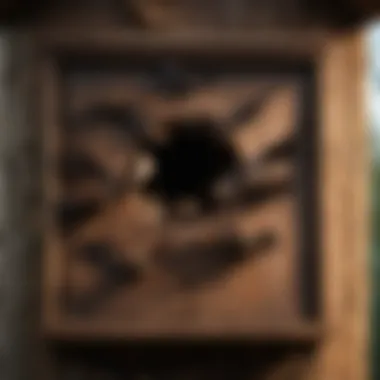

When considering neighborhoods or communities, factors like human activity must be reviewed. Installing bat houses in quieter or less disturbed areas increases the likelihood of roosting, while heavy foot traffic might deter potential bat inhabitants. Collaborating with local conservation groups can provide deeper insights into effective placement strategies based on regional bat behavior and preferences.
Height and Exposure Factors
The height of a bat house significantly influences its attractiveness to bats. Ideally, bat houses should be mounted at a height of 10 to 15 feet above ground level. This height not only provides safety from predators but also aligns with natural bat roosting habits. A bat house should be placed on a vertical surface of trees, buildings, or poles that is stable and secure.
Additionally, exposure to sunlight and wind must be factored in during placement. Bat houses benefit from receiving at least six hours of sunlight each day. Sunlight helps regulate the internal temperature of the house, making it more appealing. Proper exposure can also encourage bats to enter more readily, especially as bats often prefer warm environments for roosting.
Proximity to Water Sources
The proximity of bat houses to water sources is critical for attracting bats. Bats require water not only for drinking but also for hunting insects. Installing bat houses within one to three miles of ponds, streams, or other water bodies can enhance their appeal. Understanding local hydrology and typical bat foraging patterns can further guide placement decisions.
Furthermore, placing bat houses along migratory paths near water sources can increase visitation rates during active seasons. When considering placement, it's important to observe bat behaviors in the area to ensure houses are situated optimally.
Overall, strategic placement of bat houses can maximize their potential benefits, enhance local biodiversity, and strengthen community efforts in bat conservation.
Maintaining Bat Houses
Maintaining bat houses is crucial for ensuring their effectiveness and longevity. These structures not only provide a safe habitat for bat populations but also contribute significantly to local ecosystems. Regular maintenance helps to prevent potential issues that might deter bats from using the houses. Furthermore, maintaining these bat habitats aligns with conservation efforts. Therefore, understanding the specific processes involved in upkeep allows for optimized designs and strategies that benefit both wildlife and humans.
Regular Inspections
Regular inspections of bat houses are fundamental to their maintenance. These inspections should occur at least twice a year, ideally in spring and fall, to assess the structural integrity and cleanliness of the bat house. Observing for signs of wear, such as cracks in the wood or loose components, ensures that the shelter remains secure for its occupants. During inspections, the presence of bats can be noted, contributing to population monitoring. Monitoring also includes observing for signs of predators or competitors, which could threaten the bat population.
Cleaning Procedures
Cleaning bat houses is an essential procedure, albeit one that requires caution. It is important to clean the interior of bat houses once a year, usually in late autumn post-bat activity. Removing old guano can reduce disease risks and minimize odors, which might attract unwanted wildlife. However, it’s crucial to wear protective gear, as bat droppings can carry diseases. A simple cleaning process involves safely removing build-up with a brush or vacuum, followed by a thorough disposal of the waste. For deeper cleanliness, particularly in areas where guano accumulation is significant, a diluted bleach solution can be used to sanitize surfaces, ensuring a safe and inviting environment for the bats.
Repair and Upkeep
Repairing and maintaining bat houses includes addressing minor damages that may occur over time. It's vital to replace or fix any broken or rotting wood promptly to prevent larger problems. Checking for leaks or moisture issues is also important, as bats prefer dry habitats. Periodically applying a non-toxic sealant can help protect the wood from the elements, increasing the durability of the bat house. Routine maintenance not only helps in preserving the bat house but also plays a part in the larger environmental effort by supporting thriving bat populations in diverse ecosystems.
Proper maintenance of bat houses helps ensure that bats continue to thrive in our changing environments, demonstrating our commitment to ecological balance.
By committing to a regular inspection, careful cleaning, and timely repairs, bat house owners can significantly contribute to the well-being of these crucial mammals.
Community Involvement and Education
Community involvement in bat conservation is a fundamental aspect when discussing extra large bat houses. Engaging local communities not only enhances awareness but also fosters a sense of stewardship for bat populations. Ensuring that members are informed about the ecological role of bats, the benefits of bat houses, and the implications of bat conservation generates a collective effort, so that communities can actively participate in preserving these vital species.
Promoting Awareness
Raising awareness about bats is crucial, as misconceptions often lead to negative attitudes towards these creatures. Educational programs aimed at highlighting the ecological importance of bats can improve community perception. For example, presenting facts such as bats contributing to pest control by consuming large quantities of insects helps dispel myths of bats being harmful. Furthermore, awareness campaigns can inform residents about how extra large bat houses provide safe roosting habitats, thus assisting in bat population recovery. Simple outreach initiatives, like flyers or social media campaigns through platforms such as Facebook, can enhance reach and impact.
Workshops and Training Opportunities
Conducting workshops presents an interactive way to educate communities about bat conservation. Training sessions focus on how to effectively build and maintain bat houses. Participants can learn about the specific designs suitable for regional bat species and how to assess the local environment. Offering hands-on experiences fosters a sense of accomplishment and responsibility. Community members who participate are more likely to take action, impacting conservation efforts positively. Organizations can partner with local environmental groups to host these workshops, making it accessible and relevant.
Collaboration with Conservation Organizations
Working with established conservation organizations strengthens community efforts in bat conservation. Collaborative projects can pool resources, expertise, and funding to maximize positive outcomes. By partnering with organizations that specialize in wildlife conservation, communities gain access to knowledge and tools that may otherwise be unavailable. Such collaborations can lead to initiatives like community monitoring programs, allowing residents to take part in tracking bat populations. This involvement not only provides valuable data but also builds a sense of community ownership and commitment toward sustainable practices in line with bat conservation.
By fostering community involvement and education, we promote a healthy environment for bats. Through awareness, workshops, and collaboration, communities can engage constructively, ensuring the longevity of bat population and its ecological roles.
Case Studies of Successful Bat House Installations
Studying real-life examples of bat house installations offers invaluable insights into the practical aspects of bat conservation efforts. These case studies serve to demonstrate how well-planned bat houses can positively influence local bat populations and enhance ecological health. Understanding these instances sheds light on key benefits, practical considerations, and various factors influencing the success of such initiatives.
Urban vs. Rural Settings
The placement of bat houses in urban and rural settings presents distinct challenges and opportunities. Urban environments may offer unique niches for bats, despite higher density human populations. In cities, bat houses can benefit from natural roosting sites being limited. Successful installations in urban areas involve understanding human activity levels and potential disturbances.
On the other hand, rural settings generally allow for greater space and reduced human interference. Here, bat houses can be placed closer to natural habitats, enhancing attractiveness to local bat species.
A significant element in both settings is community engagement. In urban areas, outreach programs can educate residents about bat conservation's ecological benefits, while rural communities may experience direct economic advantages through natural pest control.


Effectiveness in Different Ecosystems
Bats exhibit adaptability to various ecosystems. An effective bat house installation must consider the specific ecological traits of its locale. For instance, in forested ecosystems, bat houses placed near tree lines provide easy access to foraging areas. Conversely, in arid environments, bat houses should be sufficiently distanced from direct sunlight and heat to avoid desiccation.
Case studies have shown varying success rates based on local flora and fauna. Areas with abundant insect populations often see higher bat occupancy rates in provided houses. Additionally, researchers monitor bat activity through acoustic studies to assess how effectively these structures support local populations. Such insights inform ongoing development and support for future installations.
Quantifying Bat Populations
Quantifying bat populations around installed bat houses provides crucial data for evaluating the success of conservation efforts. Techniques such as visual counts, acoustic monitoring, and the use of specialized software for analysis allow researchers to obtain population metrics. Studies often reveal that installed bat houses can result in a significant uptick in local bat activity.
Moreover, successful installations are frequently documented with before-and-after comparisons, demonstrating direct impacts on bat populations. This data informs not only local success stories but also wider conservation strategies, emphasizing best practices for future installations.
"Effective monitoring of bat populations helps assess the contributions of bat houses to ecological health and guides future conservation actions."
Potential Challenges and Mitigation Strategies
Addressing potential challenges associated with extra large bat houses is essential for ensuring their successful implementation and long-term effectiveness. Understanding these challenges allows for proactive strategies to be developed. This attention to detail helps both enthusiasts and professionals in ecology to create suitable environments for bats while maintaining the balance within local ecosystems.
Predation Risks
Predation is a significant concern when it comes to bat houses. Birds of prey, like hawks, can pose threats to roosting bats. Additionally, domestic cats and raccoons are common terrestrial predators that pose risks to bats when they emerge in search of food. To mitigate predation:
- Location Selection: Place bat houses in areas with minimal exposure to potential predators. Avoiding regions with high activity by these animals can lower risks significantly.
- Height Considerations: Higher placement of bat houses can deter some predators, particularly for those that primarily hunt from ground level or lower heights.
- Buffer Zones: Creating a buffer zone with natural barriers, such as dense shrubs or landscaping, can further limit access for potential predation.
Human-Wildlife Conflict
Human-wildlife conflicts can arise from the presence of bats, especially if the adjacent community misunderstands their role in the ecosystem. Fear, misinformation, and misconceptions about bats often lead to negative attitudes towards these creatures. To address this:
- Community Education: Implement educational programs focusing on the ecological benefits of bats. Highlighting their role in pest control and pollination can foster positive relationships.
- Open Communication: Residents should be encouraged to voice concerns and ask questions. Engaging with the community helps clarify misconceptions and build trust.
- Responsible Placement: Positioning bat houses away from heavily trafficked areas can minimize encounters and limit potential conflicts, allowing bats to coexist peacefully with human activities.
Climate Impact Considerations
Climate change impacts wildlife including bats. Changes in temperature and precipitation can affect bat habitats and their food supply. To counteract the ramifications of climate change:
- Adaptable Designs: Develop bat houses using materials and designs able to withstand fluctuating temperatures and weather extremes. This might include insulated structures or those that offer multiple entry points.
- Monitoring Changes: Regularly assess local climate conditions to identify shifts in temperature, humidity, or weather patterns that could impact bat populations.
- Research and Collaboration: Collaborate with local universities or conservation organizations to stay informed about climate impacts on bat species. Integrating scientific research can enhance understanding and generate innovative solutions.
By addressing these challenges proactively, stakeholders can ensure that extra large bat houses are beneficial not only for bats but also for the broader ecosystem.
Legislation and Regulations
The need for understanding legislation and regulations is critical in establishing extra large bat houses. These legal frameworks ensure that bat conservation is effective and aligns with broader environmental goals. Local laws can dictate everything from the design of the bat house to its placement, often with the aim of protecting bat populations and their habitats from human encroachment. While the intentions behind these regulations are beneficial, navigating them can be complex. It is essential to familiarize oneself with these laws to avoid complications during the installation and maintenance phases of bat houses.
Understanding Local Laws
Local laws regarding wildlife conservation vary significantly. Each region may have regulations that pertain specifically to bats, considering their status as protected species in many areas. Some laws may require residents to obtain a permit before installing bat houses. Others might establish guidelines about the type of materials to use, the size of the house, or its placement.
Residents should consult their local wildlife authority or environmental agency to understand applicable statutes. This step can help avoid inadvertent violations, which can lead to fines or removal of installations. Protecting bats often falls under broader wildlife preservation efforts, adding another layer of complexity to compliance.
Permitting for Bat House Installation
Permitting can be one of the more intricate parts of setting up extra large bat houses. In some jurisdictions, you may need a special permit, especially if your installation might affect an existing colony. Generally, the process involves submitting a detailed plan of your installation and, in some cases, an environmental impact statement.
Having a solid understanding of what is required can save time and resources. Preparing for a permitting application may also involve gathering information about bat species in your area, as different species may have different legal protections. Additionally, consultations with experts such as ecologists or environmental consultants can provide insights into minimizing impacts on local wildlife during implementation.
Protection of Bat Species
Bat conservation laws primarily aim to protect resident bat species and their habitats from harm. Some laws legally guard certain species against disturbance, especially during breeding seasons. Additionally, habitat loss due to urban expansion or agricultural development can exacerbate the challenges bats face.
Complying with protective legislation is essential for ensuring that bat populations remain sustainable. These protections can include restrictions on tree removal, cave access, and the use of pesticides that can be harmful to bats. It's not only about placing bat houses but rather creating a supportive environment for their existence and survival. Through understanding and adhering to these regulations, individuals and communities can contribute effectively to bat conservation efforts, ultimately fostering a healthier ecosystem.
Culmination
In concluding this exploration of extra large bat houses, it is essential to reinforce the importance of their role in fostering healthy ecosystems. As the article has outlined, these structures provide a safe habitat for bats, a species increasingly threatened by habitat loss and environmental changes.
Through the establishment of bat houses, individuals and organizations can assist in promoting biodiversity. This contributes not only to preserving bat populations but also supports the myriad of ecological functions they serve, such as pest control and pollination.
Summarizing Benefits
From various perspectives, the benefits of installing extra large bat houses can be synthesized into several key points:
- Habitat Creation: These bat houses create essential shelter, thereby enabling bats to thrive in areas where natural roosts are scarce.
- Pest Management: Bats are natural pest controllers. Their presence can significantly reduce the populations of insects, providing a natural form of pest management for agricultural and residential areas.
- Community Education: The installation and maintenance of bat houses can be a foundation for educational initiatives. As communities engage with bat conservation, they also develop a deeper appreciation for local wildlife and ecosystems.
- Biodiversity Support: Promoting bat populations through bat houses helps maintain balanced ecosystems, as these creatures are vital to many biological processes.
In summary, extra large bat houses not only benefit bat populations but also contribute positively to ecological health. Their design, placement, and ongoing maintenance are crucial for their success. As we reflect on the insights shared, it is clear that supporting bat conservation efforts brings numerous advantages to both human and natural communities alike.







